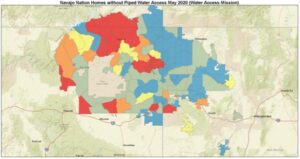“For the Navajo people, tó éí iiná até, water is life.”
–Amicus Brief of DigDeep Right to Water Project and Utah Tribal Relief Foundation

Heather Tanana and Beth Parker from the Law & Policy Program were among a small group of experts that filed an amicus brief to the Supreme Court of the United States in the consolidated cases of Arizona v. Navajo Nation (No. 21-1484) and Dep’t of Interior v. Navajo Nation (No. 22-51). The amicus brief was filed on behalf of DigDeep Right to Water Project and Utah Tribal Relief Foundation in support of the Respondent, the Navajo Nation.
Professors Tanana and Parker collaborated with the University of Minnesota Law School’s Civil Rights Appellate Clinic and three other experts—Elizabeth G. Bentley, Clifford Parkinson and Frannie Monasterio—to draft and file the amicus brief.
The amicus brief urged the Court to affirm the judgment of the Ninth Circuit and ensure fulfillment of the United States’ trust obligation to the Navajo Nation “to provide access to clean and safe water that would allow the Navajo Nation to thrive on its permanent homeland.”[1] The amicus brief examined the pervasiveness of water insecurity and poor water quality on the Navajo Nation and the resulting hardships, including health disparities and economic costs.
Water insecurity is a daily struggle on the Navajo Nation, where at least thirty percent of Navajo Nation residents lack running water.[2] Conversely, not even one percent of homes overall in the United States lack piped water.[3] Because of the lack of water access, Navajo Nation residents use, on average, only seven gallons of water a day for all basic household needs,[4] and some rely on as little as two to three gallons each day.[5] In comparison, the per capita water usage in the neighboring state of Utah is 169 gallons of water per day.[6]
Water insecurity results in severe hardships for families on the Navajo Nation. In order to obtain water, at least thirty percent of residents must haul water, buy bottled water for all their household needs, and even use contaminated water,[7] often collected from miles away and at great personal expense and effort.
In addition to water insecurity, poor water quality is also a pervasive issue on the Navajo Nation. Years of uranium mining has resulted in contamination and decreased water quality, which contributes to lack of safe water access and compromised health and welfare on the Navajo Nation.[8]
In addition to the above, the amicus brief detailed health disparities and struggles that stem from a lack of clean water access, noting that “families in the water access gap are 30 times more likely to contract [waterborne] illnesses than those living in houses with basic services.”[9] Lack of water access also results in “severe economic consequences that threaten the sustainability of the permanent homeland guaranteed in the Navajo Nation’s treaties.”[10]
Oral arguments before the United States Supreme Court were heard in the case on March 20, 2023. The amicus brief and the dire circumstances experienced on Navajo Nation were referenced during oral arguments. A decision in the case is expected in June of 2023.
Professor Tanana was also featured on NPR Weekend Edition, discussing the case and what it means for tribal water rights.
The above map of the Navajo Nation depicts areas with the highest concentration of known homes without piped water as of May 2020.
[1] Navajo Safe Water: Protecting You and Your Family’s Health, Water Access Coordination Group (last updated Sept. 15, 2022), navajosafewater.org.
[1]Arizona v. Navajo Nation and Dep’t of the Interior v. Navajo Nation, Brief Amici Curiae of DigDeep Right to Water Project and Utah Tribal Relief Foundation 33 (Feb. 2023), available at https://www.supremecourt.gov/DocketPDF/21/21-1484/254361/20230208163233914_DigDeep%20UTRF%20Amicus%20Brief%20-%20final.pdf [hereinafter Brief Amici Curiae of DigDeep and Utah Tribal Relief Foundation].
[2] Env’t Prot. Agency, Final Results: Navajo Nation Unregulated Water Source Sampling Results 3 (2010), available at https://www.epa.gov/sites/default/files/2016-06/documents/2010-08-01-navajo-water-sample-results-final-report.pdf; Closing the Water Access Gap in the United States: A National Action Plan 38 (2019) [hereinafter Closing the Water Access Gap].
[3] Ranking Member Raul M. Grijalva & Democratic Staff of H. Comm. on Nat. Res., 114th Cong., Water Delayed Is Water Denied: How Congress Has Blocked Access to Water for Native Families 1 (2016).
[4] For Many Navajo, A Visit from ‘The Water Lady’ Is a Refreshing Sight, Nat’l Pub. Radio (Jan. 6, 2015, 3:57 AM), available at https://www.npr.org/sections/codeswitch/2015/01/06/374584452/for-many-of-navajo-nation-water-delivery-comes-monthly.
[5] Closing the Water Access Gap, at 38.
[6] See USGS Water Use Data for the Nation, U.S. Geological Surv., available at https://waterdata.usgs.gov/nwis/wu (last visited Feb. 2, 2023).
[7] See Navajo Nation Env’t Prot. Agency, Pub. Water Sys. Supervision Program, Guidelines for Hauling and Transporting Regulated Water for Human Consumption 1, available at http://www.navajopublicwater.org/Guidelines_Hauling-TransportingRegulatedWater_HumanConsumption_WordDoc.pdf (last visited March 20, 2023).
[8] Brief Amici Curiae of DigDeep and Utah Tribal Relief Foundation, at 16.
[9] DigDeep, Draining: The Economic Impact of America’s Hidden Water Crisis 39 (2022), available at https://www.digdeep.org/draining.
[10] Brief Amici Curiae of DigDeep and Utah Tribal Relief Foundation, at 29.
[11] Navajo Safe Water: Protecting You and Your Family’s Health, Water Access Coordination Group (last updated Sept. 15, 2022), navajosafewater.org.


